
SAFETY SHIELD® TECHNOLOGIES™
The new Murano® uses four cameras and three radar sensors to provide input for the following technologies: Blind Spot Warning (BSW), Predictive Forward Collision Warning (PFCW), Forward Emergency Braking (FEB) and Intelligent Cruise Control (ICC). The new Rear Cross Traffic Alert (RCTA) system utilizes radar to help detect a vehicle approaching from either side of the Murano when backing out of a parking space. The Platinum model will come with Around View Monitor (AVM), designed to make parallel parking easier by giving an all-around view of the surrounding area from the front, rear and side cameras.
Nissan’s Advanced Air Bag System is standard. It has dual-stage supplemental front air bags, seat belt sensors and occupant classification sensors. Other air bags include driver and front seat-mounted supplemental side air bags for side-impact protection, and roof-mounted curtain supplemental air bags for front and rear outboard side-impact and rollover head protection. There is also a driver supplemental knee air bag to help lessen the severity of injury to the lower extremities. The new Murano also utilizes Nissan Zone Body Construction, which combines impact-absorbing structures with a high-strength cabin to help protect occupants.

BLIND SPOT WARNING SYSTEM

The Blind Spot Warning (BSW) system works to help alert the driver to vehicles in adjacent lanes when changing lanes. It uses two radar sensors installed near the rear bumper to detect these vehicles. The sensors can detect vehicles on either side of the Murano within the detection zone, which starts at the outside mirror and extends 10 ft (3 m) behind the rear bumper. It also extends 10 ft (3 m) to either side of the vehicle.
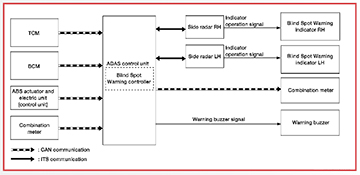
The system automatically turns on when the engine is started unless it has been disabled. The system operates at speeds above approximately 20 MPH (32 km/h). When the radar detects vehicles in the detection zone, the BSW indicator light illuminates. The system chimes twice and the BSW indicator lamp will blink if the driver uses the turn signal while there is a vehicle in the blind spot zone. The indicator light is located on the front pillar, and it continues to flash or stay illuminated until the vehicle in the detection zone leaves the zone. The brightness of the BSW indicator light is adjusted automatically depending on the brightness of the ambient light.

![]()
The radar sensors may not be able to detect and activate BSW when certain objects are present such as: pedestrians, bicycles or animals.

NOTE: If the BSW system malfunctions, it will turn off automatically and the system malfunction warning message will appear in the vehicle information display.
![]()
- The radar sensor may not be able to detect and activate the BSW when certain objects are present such as:
– Vehicles such as motorcycles, low height vehicles, or high ground clearance vehicles.
– Oncoming vehicles.
– Vehicles remaining in the detection zone when you accelerate from a stop.
PREDICTIVE FORWARD COLLISION WARNING SYSTEM
The Predictive Forward Collision Warning (PFCW) system can help alert the driver when there is a sudden braking of a vehicle traveling in front of the vehicle ahead in the same traveling lane.
SYSTEM OPERATION
The PFCW system uses a radar sensor located on the front of the vehicle to measure the distance to a second vehicle ahead in the traveling lane.
The PFCW system operates at speeds above approximately 3 MPH (5 km/h). If there is a potential risk of a forward collision, the PFCW system will warn the driver by blinking the vehicle ahead detection indicator light and sounding a warning tone.
When the sensor area of the front bumper is covered with dirt or is obstructed, making it impossible to detect a vehicle ahead, the PFCW system is automatically turned OFF.
The Forward Emergency Braking system warning light (orange) will illuminate and the “front radar obstruction” warning message will appear in the vehicle information display.
![]()
- The PFCW system helps warn the driver before a collision but will not avoid a collision. It is the driver’s responsibility to stay alert, drive safely and be in control of the vehicle at all times.
- The radar sensor does not detect the following objects:
– Pedestrians, animals or obstacles in the roadway
– Oncoming vehicles
– Crossing vehicles
NOTE:

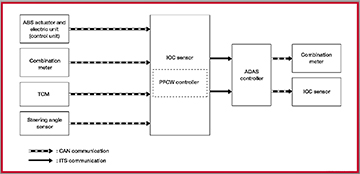
FORWARD EMERGENCY BRAKING SYSTEM
The Forward Emergency Braking (FEB) system can assist the driver when there is a risk of a forward collision with the vehicle ahead in the traveling lane. The FEB system uses the same radar sensor as the PFCW system located at the front of the vehicle to measure the distance to the vehicle ahead in the traveling lane. The FEB system operates at speeds above approximately 3 MPH (5 km/h).
![]()
If a risk of a forward collision is detected, the FEB system will provide the first warning to the driver by flashing a visual warning and providing an audible alert.
If the driver applies the brakes quickly and forcefully after the warning and the FEB system detects that there is still the possibility of a forward collision, the system will automatically increase the braking force. If the driver does not take action, the FEB system issues the second visual warning (red) and audible alert. If the driver releases the accelerator pedal, then the system applies partial braking. If the risk of a collision becomes imminent, the FEB system applies harder braking automatically.
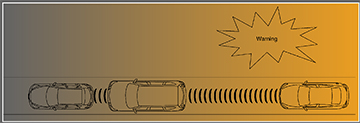
SYSTEM TEMPORARILY UNAVAILABLE
Condition A:
When the radar sensor picks up interference from another radar source, making it impossible to detect a vehicle ahead, the FEB system is automatically turned off.
The FEB system warning light (orange) and the driver assist system forward indicator (orange) will illuminate.
When the above conditions no longer exist, the FEB system will resume automatically.

Condition B:
When the sensor window is dirty, making it impossible to detect a vehicle ahead, the FEB system is automatically turned off. The system warning light (orange) will illuminate and the “front radar obstruction” warning message will appear in the vehicle information display.
Action to take:
If the warning light (orange) illuminates, park the vehicle in a safe location and turn the engine off. Check to see if the sensor window is blocked. If the sensor window is blocked, remove the blocking material. Restart the engine.
SYSTEM MALFUNCTION
If the FEB system malfunctions, it will be turned off automatically, a chime will sound, the FEB system warning light (orange) will illuminate and the warning message [Malfunction] will appear in the vehicle information display.
INTELLIGENT CRUISE CONTROL
The available Intelligent Cruise Control (ICC) system enables the driver to pre-set the distance he or she would like to maintain between he/she and the vehicle in front of him/her. When the Murano is set to cruise, the ICC maintains the distance set by the driver within the speed range of 0 to 90 MPH (0 to 144 km/h) up to the set speed. The set speed can be selected by the driver between 20 to 90 MPH (32 to 144 km/h). The vehicle travels at the preset speed when the road ahead is clear.
If traffic slows, the Murano will also slow and the system will reduce the vehicle’s speed so that the vehicle follows the vehicle ahead at the selected distance. When traffic speeds up again, the system will comfortably and automatically accelerate back up to the chosen preset speed. If the vehicle ahead comes to a stop, the vehicle decelerates to a standstill within the limitations of the system.
The ICC system can only apply up to 40% of the vehicle’s total braking power. The system will cancel once it judges that the vehicle has come to a standstill and will sound a warning chime. To prevent the vehicle from moving, the driver must depress the brake pedal.
There is a performance limit to the distance control function, so it is a good idea to inform customers not to rely solely on the ICC system. Nissan advises drivers to not use the ICC system under certain conditions such as: roads where there is heavy traffic, slippery roads, during bad weather, on a steep downhill, on hilly roads or if the driver is towing a trailer.
ICC system uses a sensor on the front of the vehicle. It works by detecting the signals returned from the vehicle ahead. The sensor may not detect the vehicle ahead when snow or heavy road spray reduces the sensor’s detection range or when the Murano is heavily loaded in the rear seat or the trunk. In some road or traffic conditions, a vehicle or object can unexpectedly come into the sensor detection zone and cause automatic braking. The system is operated by the cruise ON/OFF switch and four control switches mounted on the steering wheel.
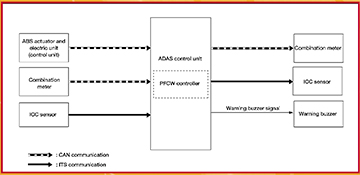

AROUND VIEW® MONITOR
The Around View® Monitor (AVM) system provides a virtual 360º birds-eye view of the vehicle exterior and near perimeter to help with identification and safe operation. The colored guide lines on the display screen indicate vehicle width and approximate distances to objects with reference to the vehicle body line: red 1.5 ft (0.5 m); yellow 3 ft (1 m); green 7 ft (2 m) and 10 ft (3 m).
The system is designed as an aid to the driver in situations such as slot parking or parallel parking.
There are some areas where the system will not show objects and the system does not warn of moving objects:
- When in the front or rear view display, an object below the bumper or on the ground may not be viewed.
- When in the bird’s-eye view, a tall object near the seams of the camera viewing areas will not appear in the monitors.
MOVING OBJECT DETECTION
The Moving Object Detection (MOD) system can inform the driver of moving objects near the vehicle when backing out of garages, maneuvering in parking lots and in other such instances. The MOD system detects moving objects by using image processing technology on the image shown in the display when the camera view is displayed. The system will operate when the vehicle is driven at speeds of approximately 5 MPH (8 km/h) or less. If the MOD system detects moving objects, a yellow frame will be displayed on the camera image and a chime will sound.
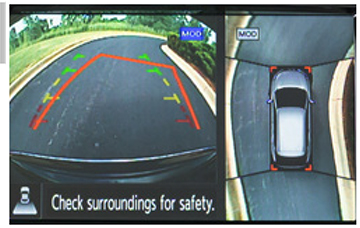
When the following is displayed:
- Blue MOD icon; the system is active.
- Gray MOD icon; the system is not active.
- No MOD icon; the system is off.
The indicator will also be off if all of the warning systems are deactivated using the Settings menu.
The MOD system will not operate if the liftgate is open.
![]()
- The system is deactivated at speeds above 6 MPH (10 km/h). It is reactivated at lower speeds.
- The MOD system does not have the function to detect the surrounding stationary objects.
REAR CROSS TRAFFIC ALERT SYSTEM (IF SO EQUIPPED)
The Rear Cross Traffic Alert (RCTA) system can help alert the driver of an approaching vehicle when the driver is backing out of a parking space. When the shift position is in R (REVERSE) and the vehicle speed is less than approximately 5 MPH (8 km/h), the RCTA system is operational.
This system provides audible and visual alerts when an approaching vehicle is detected. It uses sensors installed on both sides near the rear bumper of the vehicle to detect vehicles up to 66 ft (20 m) away. Severe weather, road spray, ice build-up and dirt build-up may impede proper function.

NOTE: The RCTA system is integrated into the BSW system. There is not a separate selection in the vehicle information display for the RCTA system. When the BSW is disabled, the RCTA system is also disabled.

NOTE: Refer to the vehicle’s owners manual for all cautions and warnings.